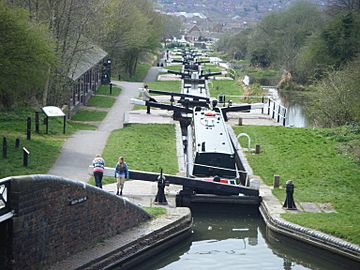Delph Locks facts for kids

The flight from lock 2
|
|
| Waterway | Dudley Canal |
|---|---|
| Maintained by | Canal & River Trust |
| Operation | Manual |
| First built | 1799 |
| Length | 70 feet (21.3 m) |
| Width | 7 feet (2.1 m) |
| Fall | 85 feet (26 m) |
| Above sea level | top lock: 441 feet (134 m) |
| Flight of 8 locks | |
The Delph Locks, also known as the Delph Nine, are a set of eight (originally nine) narrow canal locks. They are found on the Dudley No. 1 Canal in Brierley Hill, England. These locks act like water elevators, helping boats move between different water levels. They first opened in 1779. After being closed for a while, they were fixed up and reopened in 1967. This was a big project to bring the Dudley Canal and the Stourbridge Canal back to life.
Contents
History of the Delph Locks
How the Canals Began
The Dudley Canal and the Stourbridge Canal were first planned as one big canal. In 1775, a proposal was sent to Parliament to get permission. However, another canal company, the Birmingham Canal Navigations, didn't like the idea. So, the project was split into two separate canals.
Even with continued opposition, both canals were approved by Parliament on April 2, 1776. Thomas Dadford was the engineer for the Dudley Canal. This canal ended at its southern part with a series of nine locks. Construction finished in June 1779. The locks became very busy once the Stourbridge Canal opened in December of that year.
Changes Over Time
The very bottom lock of the Delph flight is where the Dudley Canal meets the Stourbridge Canal. The locks are special because they have unique waterfall overflows. They help boats climb from the Stourbridge Canal's level of about 356 feet (108.5 meters) up to the Dudley No. 1 Canal's level of 441 feet (134.4 meters).
In 1858, the middle seven of the original 1779 locks were rebuilt. This changed the flight from nine locks to eight. You can still see some old ruins of the original locks next to the newer ones.
Bringing the Canals Back to Life
Over time, boats stopped using these canals for carrying goods. By the early 1950s, the canals were not usable anymore. A group called the Inland Waterways Protection Society suggested fixing the Dudley and Stourbridge Canals in 1959. Even though the Dudley Tunnel to the north was officially closed in 1962, hope remained.
In 1964, the British Waterways Board and the Staffordshire and Worcestershire Canal Society agreed to work together. This teamwork led to the Delph Locks reopening in 1967. It was an important step in restoring these historic waterways.
Where to Find the Delph Locks
Delph 'Nine' Locks Conservation Area
The Delph Locks and the land around them are part of a special area. It's called the Delph 'Nine' Locks Conservation Area in Brierley Hill. This means the area is protected because of its history and natural beauty.
Near the top lock, there's an old iron roving bridge. This bridge was made by Horsley Ironworks. It's a special type of bridge that allowed horses pulling boats to cross the canal without unhitching.
The Lock-Keeper's House
The original house for the lock-keeper was built in 1779. It was changed a bit in the 1800s. This house is now a Grade II listed structure. This means it's an important historic building that needs to be preserved. It's one of the few lock-keeper's houses from that time that still exists.
Connecting Canals
From the top of the Delph Locks, the Dudley Canal stays level for about 1.8 miles (2.9 kilometers). It then reaches Blowers Green Lock and connects to the Dudley No. 2 Canal.
From the bottom of the Delph Locks, the Stourbridge Canal also stays level for about 1.8 miles (2.9 kilometers). It then reaches Leys Junction. From there, the Fens Branch goes northeast towards the Fens Pools reservoirs. The main Stourbridge Canal line goes down 145 feet (44.2 meters) through sixteen more locks.

